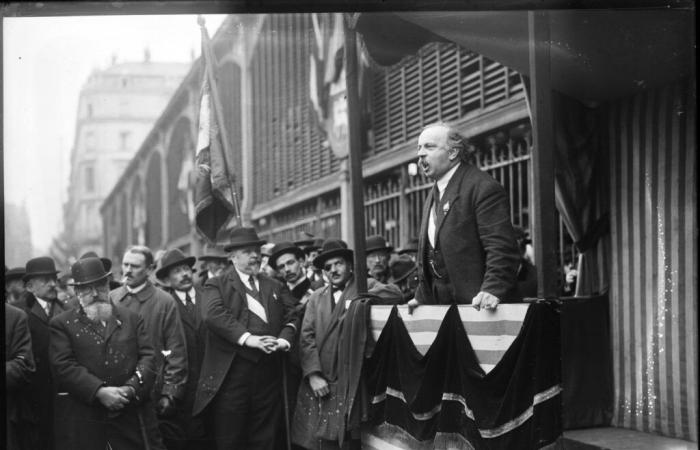
Who is Marc Sangnier and what is Le Sillon?
In 1893, a brilliant student from the Parisian bourgeoisie, Marc Sangnier was 20 years old. While he prepares for the École Polytechnique competitive exam at Stanislas College, he brings together a group of students every week in a room called “The Crypt”. A year later, in 1894, emanated from this core the writing of a small magazine entitled The Furrowwhich presents itself as the organ “from a group of young Catholic Democrats”. Marc Sangnier took over its management in 1898 and at the same time launched popular institutes – study circles operating on the principle of mutual teaching – which offered courses and conferences for young people of all social classes.
In the increasingly turbulent climate of the first years of the 20th centurye century – separation of Churches and State then condemnation of modernism – Le Sillon was criticized by both the anticlerical left and the anti-republican right, but became an influential youth movement thanks to its charismatic leader, who organized meetings public based on exchange and dialogue.
These often eventful meetings contributed to the notoriety of the Sillon and its growth: the Young Guard was created in 1902 to train a new elite of “modern day knights” (Michel Winock), then the weekly Democratic Awakening in 1905, printed in 50,000 copies, and the daily Democracy in 1908. Finally, from 1907, the work The “Greatest Furrow” seeks to “to bring together all the forces that consciously or unconsciously animate the Christian spirit”, from a non-denominational perspective.
What ideas does Le Sillon defend?
Le Sillon is heir to two fundamental movements within French Catholicism in the 19th century.e century. The first is social Catholicism, a current of thought which, starting with the industrial revolution in Europe, seeks to respond to the aspirations of the emerging working class, whose condition continues to deteriorate. Leo XIII is the first pope to encourage this commitment, in his encyclical New things in 1891. The antagonism between the Church and the Republic is the second legacy of the 19the century, which the same pope sought to put an end to in 1892 with his encyclical Amidst the concerns : he encourages French Catholics to rally around the republican regime.
While this call arouses less enthusiasm than hostility among Catholics, still faithful to the monarchy, Marc Sangnier and his movement do not only want to rally around democracy, but build it: “The Sillon aims to achieve a democratic republic in France” (The Cross1905). According to the historian Jean-Marie Mayeur, the founder “develops a conception of democracy based on responsibility and participation”, one of the major issues of which is the integration of the working class. Democracy, for Marc Sangnier, is not only a legal or political reality, but a “social organization which tends to maximize the conscience and civic responsibility of each person” (The democratic spirit, 1905).
How did the Sillon movement end and how did Marc Sangnier continue his work?
Le Sillon first received the support of the Pope and aroused the enthusiasm of the French episcopate. However, in 1910, Pope Pius X sent a letter to the bishops in which he judged that the movement “slipped into error”. He accuses him on the one hand of confusing the Catholic faith and the democratic faith, the Christian apostolate and political action. On the other hand, Le Sillon would develop, according to him, a vision of democracy independent of any Christian inspiration, by placing “authority in the people” and not in the Church, and “by separating fraternity from Christian charity”. Marc Sangnier then abandoned the leadership of the movement, as the Pope asked him to do, and called on his troops to submit.
However, he does not renounce all public life. While he had already stood for legislative elections in 1910, he founded the League of the Young Republic in 1912, seeking to allow the full participation of citizens through the establishment of the referendum and proportional representation, women's votes. , labor protection laws, or even a professional Senate, a measure supported by social Catholicism to ensure the representation of the interests of each profession. Despite the sympathy of Benedict action for peace, and launched the first youth hostels in France, an idea that he imported from Germany in 1929.
What is its legacy to this day?
The trajectory of Le Sillon and its founder illustrates the French specificity of the relative failure of Christian democracy as a partisan force but of its vigor as a current of thought. Marc Sangnier indeed retained a great influence in the interwar period, through his articles and speeches. He remains a thought leader for an entire generation at the beginning of the 20th century.e century, which he indirectly trains in politics.
It was this generation which was at the origin of the constitution of the Popular Republican Movement (MRP) in 1944, the post-war Christian Democratic party, with Maurice Schumann at its head. Marc Sangnier joins the movement as an honorary member, and believes he sees in it the realization of his hopes for half a century. Although there will certainly never be a large Christian democratic force in France like in Italy or Germany, Sangnier's prophetic work nevertheless appears to be a decisive step in the acclimatization of Catholics to the Republic.
——————-
A conference at the ICP on the latest work of Marc Sangnier
The Catholic Institute of Paris (ICP) is organizing a conference on Thursday, December 5 entitled “Marc Sangnier, from yesterday to today, an awakener” focusing on “intellectual, political, militant and religious heritage” of his work, in which both scientists and activists will participate. François Bayrou and Bernard Cazeneuve will return in particular to the way in which the figure of Marc Sangnier inspired them throughout their political career.





